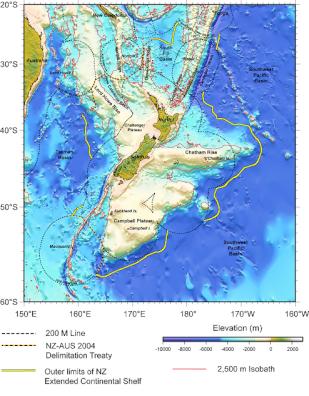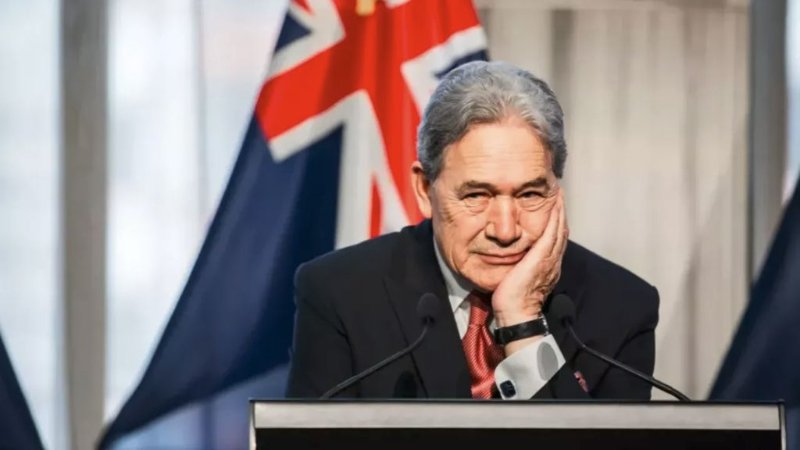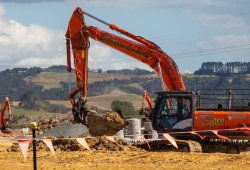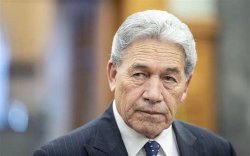New Zealand Lodges Seabed Boundary with UN
Rt Hon Winston Peters
Minister of Foreign Affairs
19
April 2006
Media Release
New Zealand Lodges Seabed Boundary with UN
New Zealand has lodged its seabed boundary with a special United Nations Commission, Foreign Minister Winston Peters said today.
“This is the result of a decade’s worth of work and scientific research, and fulfils New Zealand’s obligation under the UN Law of the Sea Convention,” Mr Peters said.
The boundary contained in the submission encompasses approximately 1.7 million square kilometres of seabed outside New Zealand’s existing 200 nautical mile Exclusive Economic Zone. The seabed in this area is known as the ‘continental shelf’.
“This area is more than six times the size of New Zealand itself. The submission will enable New Zealand to exercise its rights over the continental shelf with certainty, including its rights to valuable resources such as minerals and petroleum,” said Mr Peters.
New Zealand is entitled to the undersea resources of the continental shelf. The seas above the continental shelf are international waters, so New Zealand has no special rights to the fisheries in this area.
The submission is the product of a $44 million Government project, carried out over 10 years by officials and scientists. Special surveys were carried out to provide the information required to identify the continental shelf boundary.
The submission will be considered by the
21-member United Nations Commission on the Limits of the
Continental Shelf, based in New York, and once confirmed,
the boundary will be binding on other countries.
A
boundary will be negotiated with Fiji and Tonga over the
continental shelf to the north of New Zealand. A
continental shelf boundary was agreed with Australia in July
2004.
ENDS

Click for big version
Map showing the outer limits of the New Zealand continental shelf beyond the EEZ contained in the submission to the UN Commission on the Limits of the Continental Shelf
Background
Information
How is the Continental Shelf different from the EEZ?
The EEZ is the area extending out 200 nautical miles (NM) from the coast, including both the sea and the seabed. It is measured from the baseline of the territorial sea, generally the low water line. Within the EEZ, the coastal State has sovereign rights in accordance with the United Nations Convention on the Law of the Sea (UNCLOS) over the living and non-living resources of both the water column and the sea-bed, such as fisheries, minerals or petroleum,
The continental shelf is the seabed and the subsoil beyond the territorial sea out to 200NM from the coast or, where the “natural prolongation” of the land territory extends beyond that limit, to the outer edge of the continental margin. This is defined by UNCLOS according to a complex formula, but in no case can it extend beyond the greater of 350NM from the baseline or 100NM from the 2500m isobath (a line connecting all points lying at a depth of 2500 metres). On the continental shelf, the coastal State exercises sovereign rights over the non-living resources (such as minerals or petroleum) and sedentary living organisms (such as sponges and molluscs). States do not have any special rights to the water column above the continental shelf, so New Zealand does not have rights to the fisheries above the continental shelf beyond the EEZ or to control other activities such as shipping.
Why
did New Zealand need to lodge its submission with the
UN?
Article 76 of UNCLOS requires New Zealand to submit coordinates for the outer limits of its continental shelf beyond the 200 nautical mile EEZ to the United Nations Commission on the Limits of the Continental Shelf (the Commission). The original deadline for this submission (for New Zealand, August 2006) was extended to May 2009 by States Parties to UNCLOS. However, the work programme for completion of the New Zealand submission was established prior to that extension.
How was the New Zealand
submission prepared?
The submission is the result of a 10-year, $44 million effort that needed technical and scientific input to meet the requirements of article 76, legal input to guide the scientific objectives and the presentation of the results, and administrative input to ensure the project was completed on time and within budget.
The project was initially administered by the Ministry of Commerce, and latterly by Land Information New Zealand. Technical specialists from GNS Science, NIWA, the Navy’s Hydrographic Office, and LINZ have collaborated for seven years to gather and analyse data to define the boundaries of the submerged New Zealand continent. The Ministry of Foreign Affairs and Trade provides international legal expertise and strategic guidance for the project.
The project has had a number of phases
- Desktop studies to identify available data and areas where further work was required
- Acquisition of new bathymetry, sediment thickness and rock type data, using, among other things, seismic surveys and dredging
- Data processing and interpretation
- Compilation of the submission
- Final phase - presentation of the submission to the United Nations Commission on the Limits of the Continental Shelf (expected to take place in August 2006).
The work New Zealand has done in compiling its submission is world-leading and is being used as a guide by other countries preparing their submissions. New Zealand has already provided advice to Japan and South Africa and has contributed to international discussions on article 76 through contributions to conferences and workshops.
The risk management strategies employed by LINZ ensured that the submission was completed within the timeframe of the original work programme and within its original budget
Background information on the progress of the Continental Shelf Project can be found in the “New Zealand Continental Shelf Report” published by LINZ: www.linz.govt.nz
More information on the scientific work involved in the preparation of the submission can be found at:www.unclosnz.org.nz
What
is the role of the UN Commission?
UNCLOS provides that the Commission may “make recommendations [to New Zealand] on matters related to the establishment of the outer limits” (article 76(8)). These recommendations may either confirm the outer limits proposed in the New Zealand submission, or suggest outer limits that would alter the area of continental shelf. Although the Commission’s recommendations are not technically binding on New Zealand, they will have considerable authority and New Zealand will be expected to have due regard to the Commission’s recommendations and to establish the final outer limits of the continental shelf on the basis of them. The limits of the continental shelf established by New Zealand on the basis of the Commission’s recommendations shall be “final and binding” (article 76(8)). This means that once they have been established the outer limits cannot be changed later by New Zealand. It also means that they are binding on other States.
What is the process from here?
An Executive Summary of the New Zealand submission will be circulated to all UN member States and posted on the Commission’s website: www.un.org/Depts/los. Copies are also available from the Legal Division of the Ministry of Foreign Affairs and Trade.
The Commission will consider New Zealand’s submission at its 18th session from 21 August to 15 September 2006. At that point the Commission will establish a Sub-Commission of seven members to carry out an in-depth analysis of the submission and prepare the Commission’s recommendations. The Sub-Commission may need to meet as many as four times to complete its work. Since the Sub-Commission only meets twice a year, it is likely to be two years before New Zealand receives the Commission’s recommendations.
Based on the practice established with respect to earlier submissions, the Sub-Commission is likely to want to engage in a dialogue with New Zealand as it considers the submission. The New Zealand Continental Shelf Project team (including officials from MFAT and LINZ, and scientific experts from GNS and NIWA) will attend the Sub-Commission meetings in New York to answer any questions. The Sub-Commission may also raise questions during the period in between meetings. The Sub-Commission’s meetings are closed, and the question and answer process is confidential between the Sub-Commission and New Zealand.
What benefits will the submission bring?
The additional 1.7million square kilometres of seabed included in the submission will have cost about $26 a square kilometre. Considering the potential economic and social benefits from this extended area, many scientists consider this to be an outstanding investment.
Under UNCLOS, a coastal State exercises “sovereign rights for the purpose of exploring” the continental shelf and “exploiting its natural resources”. The natural resources of the continental shelf are defined as consisting of the “mineral and other non-living resources of the sea-bed and subsoil together with living organisms belonging to sedentary species, that is to say, organisms which, at the harvestable stage, either are immobile on or under the sea-bed or are unable to move except in constant physical contact with the seabed or subsoil”. This includes organisms such as sponges and molluscs.
The submission will confirm those rights with respect to the international community, and will define the area of New Zealand’s continental shelf in concrete geographical terms. The submission will therefore enable New Zealand to exercise its continental shelf rights with significantly greater certainty in the future. This will enable New Zealand to issue exploration and extraction licences, and will provide the commercial certainty necessary for companies to invest in resource development activities.
Relatively little is known about the resources of the continental shelf beyond the EEZ, but they may include mineral and petroleum resources, and possibly yet-to-be-discovered marine species and micro-organisms that could have potentially valuable applications in a number of sectors including medicine. Further information about the resources of the continental shelf beyond the EEZ may be obtained through the Government’s Oceans Survey 20/20 initiative.


 Gordon Campbell: On Winston Peters’ Pathetic Speech At The UN
Gordon Campbell: On Winston Peters’ Pathetic Speech At The UN Environmental Defence Society: Calls For Fast-track Approvals Bill To Be Abandoned In Submission To Select Committee
Environmental Defence Society: Calls For Fast-track Approvals Bill To Be Abandoned In Submission To Select Committee Government: Roads Of National Significance Planning Underway
Government: Roads Of National Significance Planning Underway Statistics New Zealand: Annual Food Price Inflation Slows To 0.7 Percent
Statistics New Zealand: Annual Food Price Inflation Slows To 0.7 Percent NZ Government: Joint Declaration By US Secretary Of State Antony J. Blinken And NZ Minister Of Foreign Affairs Winston Peters
NZ Government: Joint Declaration By US Secretary Of State Antony J. Blinken And NZ Minister Of Foreign Affairs Winston Peters Government: Redress For Te Korowai O Wainuiārua
Government: Redress For Te Korowai O Wainuiārua Green Party: Landlord Government Leaves Little Hope For Renters
Green Party: Landlord Government Leaves Little Hope For Renters


